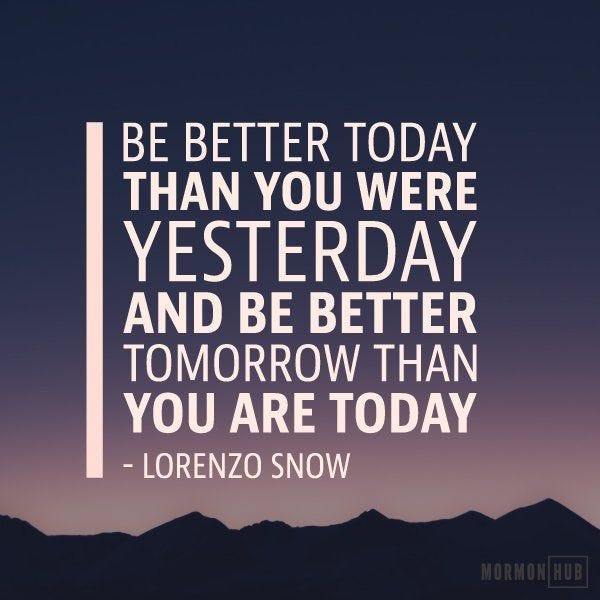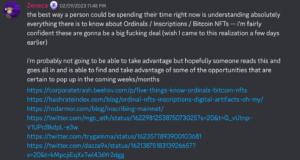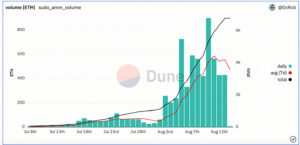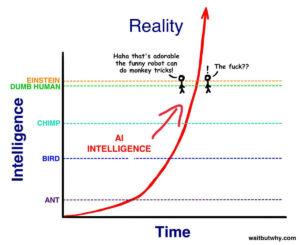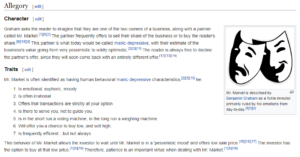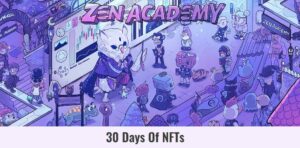An open letter to anyone launching an NFT project
Welcome to the 3,369 new subscribers who have signed up to receive these Letters since the last one went out. Join 12,376 smart people eager to learn more about the NFT space by subscribing here:
This space moves fast; lightning fast. Actually that’s underselling it – this space moves at warp speed. What worked two weeks ago might not work today, and two months ago is ancient history. This makes it incredibly difficult for a legitimate project trying to launch into this ever changing market/environment. It probably also makes it frustrating if you’ve been spending 16hr days pouring your heart and soul into a project to see it struggle to gain any momentum – meanwhile some random pixelated 10k drop comes out of nowhere and instantly sells out.
Sorry, not sorry. Be better. Don’t lament, don’t wallow in sorrow, don’t belittle other projects. Just, be, better.
Be innovative. Be interesting. Be unique. Be good. Be great. Be exceptional. Be better.
The sheer volume of NFT projects launching on a daily basis in June was ludicrous. Now it is laughable. Yes we’re early, yes there is a tonne of new people and new money entering our space every day. There is not, however, enough money to support 100+ 10,000 NFT drops a week. I mean let’s just do some napkin math. That is 1,000,000 NFTs a week, at a conservative price of 0.04 that is 40,000 ETH required for them all to sell out, or $172,000,000. This is before factoring in gas, and without even considering the money it would take to support what many consider a ‘healthy’ or ‘bullish’ secondary market.
Most projects that launch now will not sell out. Most that do sell out will not see the explosive secondary market growth that we became accustomed to over the last six months. These are facts. If you started working on a project two months ago and are trying to launch now and your entire project is “just another pfp project” with a stock-standard roadmap and nothing innovative or special.. your project is unlikely to succeed. I’m sorry, you should have been better. You took a risk trying to jump on the bandwagon and your timing was off by a couple of months. It happens. Dust yourself off, pick yourself up, and be better. Think about what actual value you can add to the community at large rather than providing “just another animal community”.
We’re in an NFT bear market right now. The cause is multi-faceted: ETH prices are at all time highs, and gas prices are consistently high. The most significant contributing factor to the bear market though, to my mind, is the sheer volume of low-effort projects. I’m not talking specifically about those that literally pop up within 24hrs, but even those that have been in the works for weeks or months yet are still indistinguishable from the crowd. The NFT market was in a state of mania for a while where we were fascinated by almost any half-interesting project that dropped.
We are no longer fascinated by a cute animal. We are now a lot more discerning with our purchases; there is a real flight to quality happening. The flight is to the established Blue Chips of the space (think punks, apes, cool cats, vee friends, blitmaps) and to the rare new project launching that really are exceptional.
The market is skittish; it is fearful. Most would-be minters are playing the “let’s wait for others to mint first” game before diving into a project that they would have instantly aped into a month ago. The entire buyers market is playing chicken with one another waiting for someone else to get the ball rolling; most of the time, the ball barely moves.
So what should a project thinking of launching do?
That’s easy. Be better.
Okay okay sorry I’m in a mood – let’s dive into it a bit more. How can you be better? First of all I think it’s important to realise and understand what you’re trying to do when you sell out a 10k collection at 0.05 or 0.1 ETH. You’re trying to generate $2-$4 MILLION dollars in revenue. This is not easy. It should not be easy. Yeah sure a few months ago it was easy, but that was then and this is now. Understand how fast this space moves and be ready and willing to adapt and adjust. It’s not easy. It’s not meant to be easy.
Consider where your value proposition is coming from. Why should someone buy your NFT? There is a lot of competition out there. What can you offer that nobody else can? If your answer is “I don’t know” or just “we’re super passionate and will do everything for our holders” then that’s not gonna cut it. The market needs to find a reason to value your NFT above others.
This is where innovation is (often, but not always) rewarded. If you do something new, and execute well, the market tends to appreciate and value the effort and ingenuity. Be the project that the next 500 projects want to copy; don’t be one of the 500 copying. Be the shepherd, not the sheep. Be better.
Build a community before you launch
This is becoming more and more important. If community is a major aspect of your selling point (and even if it isn’t), you want to have a strong community built before you sell a single NFT. This is the thing that most projects asking for my advice most want input on: how can we get the word out and market and promote and get people invested in our project? how can we build a strong community? how can we get xx,xxx Discord members and Twitter followers?
Simple. Be better. Also, time.
There are no shortcuts. There is absolutely no substitute for time when it comes to organic growth; and there is no substitute for organic growth when it comes to building a strong community that is built on bricks and not sand. If you create a good product and have something of value to offer to the community, then all it takes is a bit of (or a lot of) elbow grease to get the word out and it will organically spread.
If you build it, we will come.
But freaking build it first. Make something awesome; create something nobody else has even dreamed of. Do something innovative. Push the boundaries. If you’re chasing, you’re setting yourself up for failure. If you’re leading, you’re setting yourself up to succeed. It may take time; it probably will. If you’re trying to “get rich quick” then you’re counting on too many factors outside your control, in my opinion. You’re hoping that the market will fomo into your project because it’s like all the others that have been successful, or that the market will act maniacally again and inhale any NFT project in sight.
Get rich quick attempts rarely work. Sometimes they do – but usually when they do, it’s because the people just got lucky. Right place, right time. Don’t pin your hopes on being in the right place at the right time and having that be enough to be successful. I’ll let you in on a secret – you’re already in the right place at the right time. This is it. We ARE still early, unfathomably early. You have one of the crucial ingredients for success, now you have to use it to cook up something the market wants and values.
On whitelists, invite contests, and level grinding
I went on vacation from the end of August to mid September. I was away for about three weeks. Upon returning it really did feel like the entire landscape of NFT drops had changed. Before I left, whitelists were almost ‘not a thing’. When I got back, it seemed like every project had one.
It seemed like everyone loved them. It was the market’s answer to gas wars. Why should people that want to buy into a project have to pay 5-10x the mint price in gas? Surely there’s a better way? Enter whitelists. A whitelist is essentially a list of pre-approved ETH addresses that have 1 to x NFTs reserved for them, usually allowing them to mint at any time during a 12-24hr window in order to avoid a gas war.
Buyers loved this – less gas. Projects loved this – ‘guaranteed’ minters. Whitelist spots were given out to early supporters of projects – those that joined the Discord early, for example. As a reward for finding and supporting a project early you could avoid a gas war and mint before everyone else. This was great and all but if you allow 1500 NFTs to be minted by these early supporters, there’s still 8500 left for a public sale + gas war. Great for those whitelisted; not so great for those not.
Projects began to expand their whitelisting criteria, in order to whitelist more people. Someone had the brilliant idea to hold “invite contests” in Discord. Invite 5 friends and guarantee yourself a whitelist spot. This is win, win, right? The project gets more exposure and Discord members, and a member gets a whitelist spot. In theory this works kinda nicely; in practice, it alienates those that don’t have that many friends, and it encourages people to invite bots and/or create multiple fake accounts to pad their invite numbers.
It also kinda annoys a lot of Discord users since we end up getting spammed with invite links. Still, it worked well for a while, and in some instances can still be a part of an effective sale strategy. It is effective at getting people through the door and into your Discord server – even if they just joined to help a friend, or because they themselves wanted to try and get a whitelist spot (before even knowing what the project is about). It is now on you to make them want to stay, and make them want to buy into the project.
I cannot overstate this. If your entire project is unimaginative and you have a stock-standard roadmap, and your entire marketing/growth strategy is to give out whitelist spots via invite contests.. you are sorta trying to create value out of nothing. Instead, create the value first, and use your marketing/growth strategy to show it to people. Make it so that if someone gets an invite to your Discord server, they go “oh WOW, this project is DIFFERENT” within three minutes of being in there. If you can’t do that, you probably shouldn’t be trying to raise millions of dollars by selling an NFT.
Level grinding is another way that projects give out whitelist spots. This is essentially a way of encouraging people to chat in their Discord server so that it appears to be active and buzzing, and rewarding those that chat the most. In theory this can be a nice way to reward active members; in practice it jus encourages a lot of low-effort chat and pisses people off. If you want to award whitelist spots to active members, do it retroactively.
There are many other ways projects give out whitelist spots – some clever and appreciated, and some boring and loathed. Be clever and appreciated, and don’t be boring and loathed. Be better.
I mentioned before that when I returned from my vacation in mid September, whitelists were all the rage. The community seemed to love them all the way up to mid-late October. Then I sensed sentiment starting to shift, and I think it was largely due to the fact that people were fed up with the methods for getting on whitelists – but also anyone that missed out on a whitelist was fed up with having to pay a premium in a gas war or on secondary to buy something for a premium over what a whitelisted buyer had to pay.
This space moves at warp speed. What was in vogue one week can be hated the next. Not even mentioned in this Letter is the crazy trend that projects went through of creating an ERC-20 token in order to provide a yield or passive income to their holders. Too many new projects scrambled to add this before truly thinking through the ramifications. It only took a week or two before community sentiment shifted massively to be weary of such projects (largely due to SEC concerns). I digress.
It is good that projects are experimenting with different drop methods. Gas wars are bad and I think we can all agree that finding a way to do away with them is going to benefit the whole space. Experimenting with whitelists is good; experimenting with dutch auctions is good; experimenting with raffles is good. This is how we innovate, learn, and push the needle forward. Honestly, we might never find the perfect solution – and we probably won’t need to. As long as we keep trying new things and finding good enough solutions, we’ll be fine. ETH 2.0 will be here, and more and more activity has moved (and will continue to move) to layer 2s, side chains, and other blockchains.
It’s hard to say what the future holds for whitelists. I have been saying for months that I would love to see a project launch a collection of 10,000 with a hard cap of one per owner. It didn’t seem too feasible months ago when demand was a lot lower, but with increasing demand, I don’t see why we don’t see this – and more of it. I think some projects intentionally don’t want to do a full whitelist because the environment created with a public launch + gas war + people missing out generates a lot of FOMO and hype which fuels their secondary market.
A healthy secondary market is good for a project; it is good for those that minted and supported the project early, and it is good for the project due to royalties. It is ideally also good for those buying on secondary – they’re valuing the NFT at a price higher than what they’re paying for it (else why would they be buying it)? If the team behind a project continues to “be good”, they will ideally be taking actions that creates and increases the value of their NFTs and the whole project and as a result have more people willing to pay higher amounts on secondary to be a part of the project.
A lot of projects spend so much of their time and attention focusing on selling out their collection, and neglect to think about how to create a healthy secondary market. Hint: it is not done by using your treasury to sweep the floor or to incentivise holders to de-list their NFTs to artificially raise the floor. This is akin to trying to create value out of thin air; how about you use the funds raised to actually create something awesome, to build something innovative, to make both holders of your NFT + outsiders looking in sit up and go “oh, wow”. That’s what creating value looks like.
This is not easy to do. There are no short cuts, and there are no magic formulas. You can copy what previously successful projects have done and ride their coattails to some degree – but in order to be truly successful, you really must be innovative. You must be better.
Here’s the top 10 projects sorted by floor price that I track on my twitter Daily Stats updates. These projects all did something innovative, and all have exceptional teams/people working on them in order to execute their visions at the highest level. I think Cool Cats were perhaps the ‘least innovative’ of the crowd when they launched, but they have some very intriguing things planned and the level of their success is a testament to the excellent people working on the project.
Being innovative and having an excellent team are two of the key ingredients for incredible success in this space. They are not the only ingredients, and having them does not guarantee success. There are a good number of projects that are being innovative and have great people working on them that are struggling to see the same level of commercial success as the ones in the table above. One thing is for sure though, there are exactly zero projects that are not being innovative and have mediocre teams that are ever going to truly excel.
This actually brings me to what I think is the single most important ingredient for success in this space:
Networking
If you are new to the space and are trying to launch a project with hardly any contacts in the space, you are going to struggle. Occasionally a new project by a completely random/anon creator comes along and succeeds, but this is by far the exception. One thing you’ll notice is that if a “crypto OG” launches a project, it is almost destined to succeed. The definition of what an OG is varies, but let’s say someone that has been in the space for 4+ years and isn’t one of the (many) of us that decided to run away back to real life when the bear market hit.
They stayed, and built, and networked, and worked. They got better. They invested in themselves and they invested in others. If they decide they want to launch an NFT project now, not only are they likely to bring a wealth of experience to the table – they probably know dozens if not hundreds of other “OGs” that are willing to back and support them, and usually rightfully so.
That’s not particularly helpful if you’re trying to launch a project next week that you started working on last month after learning about what Ethereum is in June. It is a reality check, though. The longer you spend in this space, and the longer you spend actively engaging with others in this space, the more likely you are to succeed in the long run.
Remember that this is a marathon, not a sprint. If you’ve read this Letter and feel like your project isn’t exceptional, doesn’t stand out from the crowd, doesn’t have a strong organic community, and that you don’t have a network to rely on – just remember, you are still early. Learn from your experiences, and improve upon them. Stay in this space. Get better. Be better.
Bear markets are where the true building happens. Bear markets are where true wealth is made. Not just financial wealth – also mental wealth, and social wealth. I don’t know if this bear market we’re currently in is “the big one” that is inevitable and will last many months if not years. I do know that in 10 years we’ll look back at this moment and marvel at how truly early we were.
I also know that most people that are here just for the money are going to get bored and dejected as the bear market wears on. They will stop engaging with the community, they will stop networking. They will stop investing in themselves. You can already see it happening – a lot of people in the NFT space have already shifted their attention to alt coins to try and make a quick buck.
We’re still pretty early for a lot of alt coins, but we are astonishingly early for NFTs. Prices might tank for the next 18 months, who knows. That simply does not change the fact that we are outrageously early. In fact yesterday I said to someone that we might be too early. The world might not be ready for mainstream NFT adoption yet. Heck, the NFT space might not be ready for mainstream NFT adoption yet.
The NFT space doesn’t need another mediocre project. We are up to our ears in those. We need you to take things to the next level. We need you to build something so awesome we can’t ignore it. We need you to be better.
If you think you’ve truly created something exceptional, and amazing, and are unhappy to see that you haven’t found the attention or success yet – one of two things is happening. Your product isn’t actually that great (sorry), or you haven’t given it enough time.
Time in the NFT space is weird. You might feel like you need to rush to market, or that if you don’t have a 10k member discord community in two weeks you’re failing. You don’t and you’re not. Give us time to find your awesome project; we will. Give us time to fall in love with your project; if it’s truly great, we will. If it’s not, well, go back to the drawing board and try again. Learn, improve, reinvent. Be better.
Please, be better.
A quick note to announce that I have my first NFTs coming out soon. You can find all the details in my tweet below. I’ll try to always be better.
<div class="tweet" data-attrs="{"url":"https://twitter.com/Zeneca_33/status/1453207533049552896","full_text":"My NFT – 'A Letter from Zeneca' – The DetailsnnWhitelist Form for '333' tier: forms.gle/3BhrPHW258Fa1n…nnWen? Soon. How soon? Launch will *probably* be between 3-10 days from now. ","username":"Zeneca_33","name":"Zeneca_33 🍌","date":"Wed Oct 27 03:50:49 +0000 2021","photos":[{"img_url":"https://pbs.substack.com/media/FCrT5cyX0AETQvN.jpg","link_url":"https://t.co/7lkwkbCJtS","alt_text":null},{"img_url":"https://pbs.substack.com/media/FCrT6ZSXIAQh5kZ.jpg","link_url":"https://t.co/7lkwkbCJtS","alt_text":null}],"quoted_tweet":{},"retweet_count":92,"like_count":750,"expanded_url":{},"video_url":null,"belowTheFold":true}”>

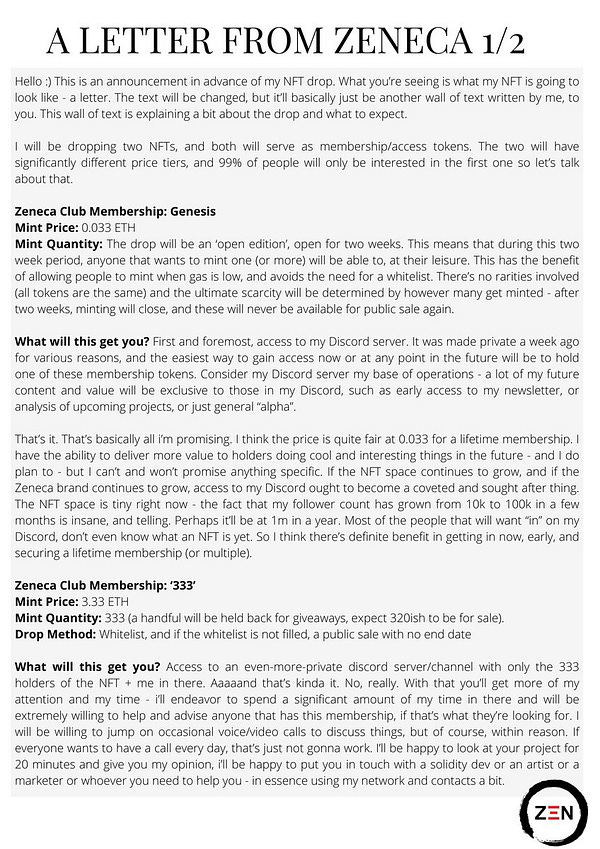
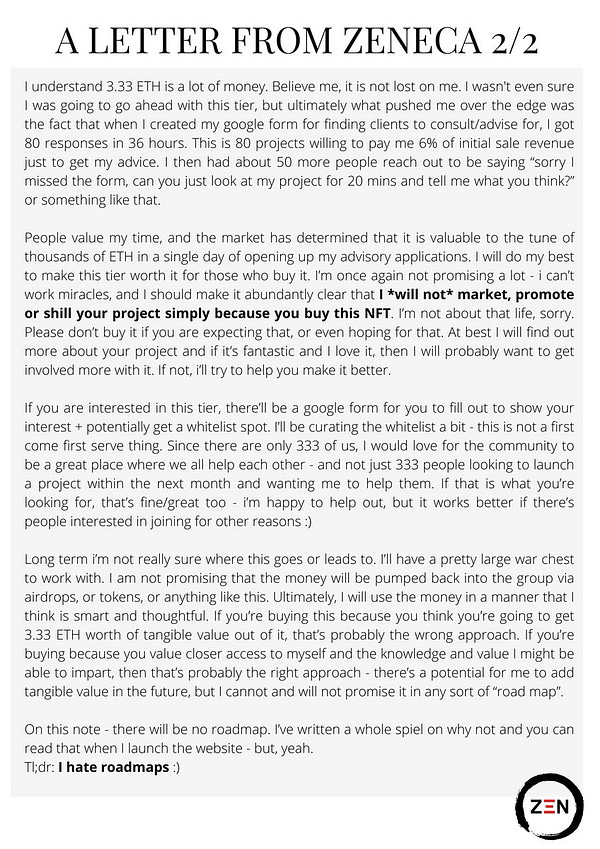
Disclaimer: The content covered in this newsletter is not to be considered as investment advice. I’m not a financial adviser. These are only my own opinions and ideas. You should always consult with a professional/licensed financial adviser before trading or investing in any cryptocurrency related product.
- SEO Powered Content & PR Distribution. Get Amplified Today.
- PlatoAiStream. Web3 Data Intelligence. Knowledge Amplified. Access Here.
- Minting the Future w Adryenn Ashley. Access Here.
- Buy and Sell Shares in PRE-IPO Companies with PREIPO®. Access Here.
- Source: https://zeneca33.substack.com/p/letter-21-be-better
- :has
- :is
- :not
- :where
- $UP
- 000
- 1
- 10
- 10K
- 14
- 15%
- 20
- 24
- 27
- 40
- 49
- 50
- 500
- 7
- 72
- 9
- a
- About
- above
- Accounts
- Act
- actions
- active
- activity
- actual
- actually
- adapt
- add
- addresses
- Adoption
- advice
- After
- again
- ago
- AIR
- All
- allow
- Allowing
- along
- already
- also
- Alt coins
- always
- amazing
- amounts
- an
- Ancient
- and
- animal
- Announce
- Another
- answer
- any
- anyone
- Apes
- appreciate
- ARE
- AS
- aspect
- At
- Attempts
- attention
- Auctions
- AUGUST
- auto
- avatar
- avoid
- award
- away
- back
- ball
- basis
- BE
- Bear
- Bear Market
- bear markets
- became
- because
- becoming
- been
- before
- began
- behind
- being
- below
- benefit
- Better
- between
- Big
- Bit
- blockchain
- blockchains
- Blue
- board
- body
- Bored
- Boring
- both
- bots
- boundaries
- brilliant
- bring
- Brings
- build
- Building
- built
- but
- buy
- buyers
- Buying
- Buzzing
- by
- CAN
- cannot
- cap
- Cats
- Cause
- chains
- change
- changed
- changing
- check
- Chips
- Coins
- collection
- comes
- coming
- commercial
- community
- competition
- completely
- Concerns
- conservative
- Consider
- considered
- considering
- contacts
- content
- continue
- continues
- contributing
- control
- Cool
- Cool Cats
- copying
- could
- counting
- Couple
- covered
- crazy
- create
- created
- creates
- Creating
- creator
- criteria
- crowd
- crucial
- cryptocurrency
- Currently
- Cut
- cuts
- daily
- day
- Days
- decide
- decided
- Degree
- Demand
- details
- DID
- different
- difficult
- discord
- do
- does
- Doesn’t
- dollars
- done
- Dont
- Door
- dozens
- drawing
- Drop
- dropped
- Drops
- due
- during
- Dust
- Dutch
- eager
- Early
- easy
- Effective
- effort
- else
- encourages
- encouraging
- end
- engaging
- enough
- enough money
- Enter
- entering
- Entire
- Environment
- ERC-20
- essentially
- established
- ETH
- Eth 2.0
- ethereum
- Even
- EVER
- Every
- every day
- everyone
- everything
- exactly
- example
- Excel
- excellent
- exception
- exceptional
- execute
- Expand
- experience
- Experiences
- Exposure
- fact
- factor
- factors
- facts
- failing
- Failure
- fake
- Fall
- false
- far
- FAST
- feasible
- Fed
- feel
- few
- financial
- Find
- finding
- fine
- First
- flight
- Floor
- FLOOR PRICE
- focusing
- followers
- FOMO
- For
- form
- Forward
- found
- friend
- friends
- from
- frustrating
- fuels
- full
- funds
- future
- Gain
- game
- GAS
- gas prices
- generate
- generates
- get
- getting
- Give
- given
- Go
- going
- good
- great
- grinding
- Growth
- guarantee
- had
- Happening
- happens
- Hard
- Have
- having
- healthy
- Heart
- help
- helpful
- here
- High
- higher
- highest
- Highs
- history
- Hit
- hold
- holders
- holds
- Honestly
- hopes
- hoping
- How
- How To
- However
- HTTPS
- Hundreds
- Hype
- i
- I’LL
- idea
- ideas
- if
- image
- important
- improve
- in
- Income
- Increases
- increasing
- incredible
- inevitable
- innovate
- Innovation
- innovative
- input
- instantly
- instead
- intentionally
- interesting
- into
- invested
- investing
- investment
- invite
- IT
- join
- joined
- jpg
- jump
- june
- just
- Keep
- Key
- Know
- Knowing
- landscape
- large
- largely
- Last
- launch
- launched
- launches
- launching
- layer
- Layer 2s
- leading
- LEARN
- learning
- left
- legitimate
- less
- letter
- Level
- Life
- lightning
- like
- likely
- links
- List
- Long
- longer
- Look
- looking
- LOOKS
- Lot
- love
- loved
- made
- magic
- Mainstream
- major
- make
- MAKES
- many
- Marathon
- Market
- Markets
- marvel
- massively
- math
- May..
- mean
- meant
- Meanwhile
- member
- Members
- mental
- mentioned
- methods
- Mid
- might
- millions
- mind
- mint
- minted
- minutes
- missing
- moment
- Momentum
- money
- Month
- months
- mood
- more
- most
- move
- moves
- much
- multiple
- must
- my
- Need
- needs
- network
- networking
- never
- New
- Newsletter
- next
- next week
- NFT
- nft drops
- nft market
- NFT Project
- NFT projects
- NFT space
- NFTs
- nice
- no
- nothing
- Notice..
- now
- number
- numbers
- Oct
- october
- of
- off
- offer
- often
- Okay
- on
- ONE
- ones
- only
- open
- Opinion
- Opinions
- or
- order
- organic
- Organic Growth
- organically
- Other
- Others
- our
- out
- outside
- over
- own
- owner
- pad
- part
- particularly
- passionate
- passive
- passive income
- Pay
- paying
- People
- perfect
- perhaps
- pick
- Place
- planned
- plato
- Plato AiStream
- Plato Data Intelligence
- PlatoAiCast
- PlatoData
- playing
- Point
- pop
- practice
- Premium
- pretty
- previously
- price
- Prices
- probably
- Product
- project
- projects
- promote
- proposition
- provide
- providing
- public
- punks
- purchases
- Push
- quality
- Quick
- Rage
- raise
- raised
- random
- RARE
- rather
- Read
- ready
- real
- real life
- Reality
- really
- reason
- receive
- related
- rely
- remember
- required
- reserved
- result
- returning
- revenue
- Reward
- rewarded
- rewarding
- Rich
- Ride
- right
- Risk
- roadmap
- Rolling
- round
- royalties
- Run
- rush
- Said
- sale
- same
- SAND
- say
- saying
- SEC
- secondary
- Secondary Market
- Secret
- see
- seem
- seemed
- sell
- Selling
- selling point
- Sells
- sentiment
- September
- setting
- sheep
- shift
- shifted
- Short
- should
- show
- side
- Sight
- signed
- significant
- simply
- since
- single
- SIX
- Six months
- smart
- So
- Social
- solution
- Solutions
- some
- Someone
- something
- Soon
- Soul
- Space
- special
- specifically
- speed
- spend
- Spending
- Spot
- spread
- Sprint
- stand
- started
- Starting
- State
- stats
- stay
- stayed
- Still
- Stop
- Strategy
- strong
- Struggle
- Struggling
- subscribers
- succeed
- success
- successful
- such
- Super
- support
- Supported
- supporters
- Supporting
- surely
- Sweep
- table
- Take
- takes
- taking
- talking
- tank
- team
- teams
- testament
- than
- that
- The
- The Future
- the world
- their
- Them
- themselves
- then
- theory
- There.
- These
- they
- thin air
- thing
- things
- think
- Thinking
- this
- those
- though?
- three
- Through
- tier
- time
- timing
- to
- today
- token
- tomorrow
- too
- took
- top
- Top 10
- track
- Trading
- treasury
- Trend
- true
- truly
- try
- tweet
- two
- understand
- unique
- Updates
- upon
- us
- use
- users
- using
- usually
- vacation
- value
- Values
- valuing
- very
- via
- visions
- volume
- wait
- Waiting
- want
- wanted
- wants
- war
- was
- Way..
- ways
- we
- Wealth
- Web3
- week
- Weeks
- WELL
- went
- were
- What
- when
- which
- while
- whitelist
- WHO
- whole
- why
- will
- willing
- win
- with
- within
- Word
- Work
- worked
- working
- works
- world
- would
- WoW
- X
- years
- yes
- yet
- Yield
- you
- Your
- yourself
- zero

